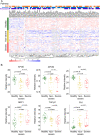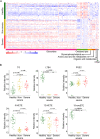Plasma proteomic and metabolomic characterization of COVID-19 survivors 6 months after discharge
- PMID: 35288537
- PMCID: PMC8919172
- DOI: 10.1038/s41419-022-04674-3
Plasma proteomic and metabolomic characterization of COVID-19 survivors 6 months after discharge
Abstract
Coronavirus disease 2019 (COVID-19) has gained prominence as a global pandemic. Studies have suggested that systemic alterations persist in a considerable proportion of COVID-19 patients after hospital discharge. We used proteomic and metabolomic approaches to analyze plasma samples obtained from 30 healthy subjects and 54 COVID-19 survivors 6 months after discharge from the hospital, including 30 non-severe and 24 severe patients. Through this analysis, we identified 1019 proteins and 1091 metabolites. The differentially expressed proteins and metabolites were then subjected to Gene Ontology and Kyoto Encyclopedia of Genes and Genomes pathway enrichment analysis. Among the patients evaluated, 41% of COVID-19 survivors reported at least one clinical symptom and 26.5% showed lung imaging abnormalities at 6 months after discharge. Plasma proteomics and metabolomics analysis showed that COVID-19 survivors differed from healthy control subjects in terms of the extracellular matrix, immune response, and hemostasis pathways. COVID-19 survivors also exhibited abnormal lipid metabolism, disordered immune response, and changes in pulmonary fibrosis-related proteins. COVID-19 survivors show persistent proteomic and metabolomic abnormalities 6 months after discharge from the hospital. Hence, the recovery period for COVID-19 survivors may be longer.
© 2022. The Author(s).
Conflict of interest statement
The authors declare no competing interests.
Figures




References
-
- Berekaa MM. Insights into the COVID-19 pandemic: Origin, pathogenesis, diagnosis, and therapeutic interventions. Front Biosci (Elite Ed) 2021;13:117–39. - PubMed
Publication types
MeSH terms
LinkOut - more resources
Full Text Sources
Medical

